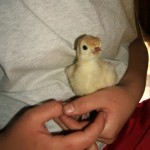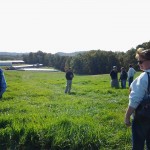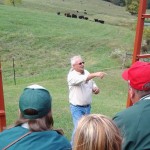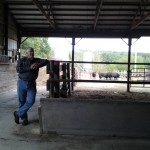 Have You Checked into Raising Chicks?
Have You Checked into Raising Chicks?
This article originally appeared in the March 21, 2016 edition of The Journal Leader.
Often people will purchase chicks as temporary pets to entertain children as a part of celebrating Easter, but before long, these adorable little balls of fluff begin to hit puberty and turn into ragamuffin teenage birds. At this point they often lose their appeal and those who bought these cuties begin looking for a way out of keeping them.
“If only more buyers would be investors!” I have thought to myself. Raising an animal is a great way to teach a child responsibility and get a return on your investment (eggs or meat). Of all the types of livestock to undertake as a starter project, poultry is one of the easiest. In addition, the initial investments and maintenance costs are low compared to those for larger types of livestock. From my point of view, one of the most appealing aspects of raising poultry is that you can have a marketable product very quickly. Market broiler chicks can reach ready to eat weight in 5-6 weeks. At 20-24 weeks roosters reach maturity and hens begin laying eggs. You can even have a market ready turkey at 22 weeks.
If you find yourself considering purchasing chicks, here is some important information to be aware of before you buy:
- You will need to check local ordinances, zoning laws, and property association rules to make sure raising and keeping poultry is permitted in your area.
- Check if you are buying market birds or layers. Also check if they have been sexed (gender identified) or not. Birds sold in a straight run have not been sexed and your ratio of males to females is luck of the draw.
- Baby chicks need to be kept warm and dry. Without a mother hen, you will need to supply a safe, warm, and confined area to keep the chicks for the first few weeks. This area should include clean bedding, access to clean water and feed, and a heating lamp.
- Some of your chicks may die. There are many reasons why you may lose a percentage of your chicks (in these conditions, 20% is common). When mortality occurs, remove and dispose of the bird immediately and ensure that everything within the chicks’ environment is clean.
- As the birds mature they will need different types of feed (starter feed, then grower feed, then layer feed) and additional space. There are many systems you can use to house the birds depending on your preferences. Research these systems and construct a plan before you buy your birds.
These are just a few important tips. Call, click, or stop by the Noble County Extension Office if you are interested in starting poultry. There is a wealth of information available on this subject and I would be happy to help you find it.
If you are curious about what types of poultry are available and/or are interested in buying, try contacting Meyer Hatchery of Polk, OH (www.meyerhatchery.com) or Mt. Healthy Hatchery (www.mthealthy.com) of Cincinnati, OH. Both hatcheries are reputable suppliers, locally owned and operated, and offer a wide selection of birds for purchase.
Livestock Mortality Composting
Livestock death is an unfortunate reality that comes with the territory of farming. Inadvertent mortalities can occur as a result of predation, illness, and accidents. Although it is unpleasant to address, safe disposal of a perished livestock animal is a necessary task. The Ohio Department of Agriculture administers the regulations on allowable methods of disposal, which include: incineration, burial, rendering, or composting. Rendering plants have diminished in the local area, burial causes concerns about ground water pollution, and incineration can be quite expensive. Of all the options for disposal, composting is one of the most effective and efficient methods; especially for small scale farms that have large size livestock.
In Ohio, cattle, horses, poultry, sheep, goats, and swine may all be composed on-farm, given that the operator has secured certification through a sponsored training course. Composting is a natural biological process in which fresh organic material (in this case an animal carcass) is converted into stabilized organic residue. Although it is the same general principle, livestock mortality composting is trickier than composting kitchen scraps. Therefore, it is important that farms who chose to compost complete adequate training.
Livestock Mortality Composting Training is available through OSU Extension by request. Contact Christine at gelley.2@osu.edu or 740-305-3173 to set up an opportunity that works for you.
Basic Disease Prevention Goes a Long Way in Herd Health
This article was also printed in the October 31, 2016 edition of The Journal.
Caring for groups of livestock and groups of young children share many similarities when it comes to disease prevention and control. I am reminded of this a week after Hand, Foot, and Mouth Disease (HFMD) came home with our daughter for the third time since August. Since they often inhabit the same spaces, they eat, drink, and play together. Both young children and livestock taste surfaces while exploring their environments. It’s wonderful for developing social skills and also wonderful for spreading pathogens. Neither toddlers or livestock can effectively wash their bodies after every encounter with an infected individual or contaminated surface. As caregivers, we have to do our best to prevent disease from entering the system, because once it is there, control becomes increasingly challenging. Some illnesses can be treated effectively with antibiotics, but the more we use antibiotics, the greater resistance is built within the bacterial population. Not to mention, that viruses (like HFMD) cannot be treated with antibiotics. Given all this, the best way to fight illness is through prevention.
Beginning on January 1, 2017 Veterinary Feed Directives (VFD) will be required for use of any fed antibiotics for livestock that are also medically important for humans. A VFD is similar to a prescription, but does not need to be filled by a pharmacist, only approved by your veterinarian. Feed stores can continue to sell feeds and minerals containing antibiotics, but the seller must have a current VFD to buy them. Antibiotic feeds have been used for years as ways to prevent and treat bacterial illnesses in livestock and this has helped improve herd health. In conjunction, antibiotic feeds have been used unethically by some parties to promote weight gain or to compensate for sub-par management practices. Research has shown and concluded that overuse of antibiotics increases resistance to their effectiveness in the long run. Therefore, it is important for human and animal health to only use antibiotics when disease is a present threat (not just suspected) and in an ethical manner.
There are many ways to stop disease before it starts and they have been identified for livestock producers in quality assurance (QA) guidelines. To quote the Good Production Practices (GPP) factsheet, “It is every animal owner’s responsibility to assure that proper management and welfare are at the core of animal care.” There are ten core GPPs:
- Use an appropriate veterinarian/client/patient relationship as the basis for medication decision-making.
- Establish and implement an efficient and effective health management plan.
- Use antibiotics responsibly.
- Properly store and administer animal health products.
- Follow proper feed processing protocols.
- Establish effective animal identification, medication records and withdrawal times.
- Practice good environmental stewardship.
- Maintain proper workplace safety.
- Provide proper animal care.
- Utilize tools for continuous improvement.
These are the core guidelines for herd health. Inevitably, disease will still get through our barriers on occasion. When it does consult your veterinarian about how to treat the herd, whether it be with medication, isolation of infected animals, or improved practices.
Beef, Forage, and Sheep Schools Were Offered in October
Bottom Left: Jason Tyrell of Guernsey County SWCD encourages beef producers to evaluate their pastures and utilize pasture score sheets. Bottom Center: Dr. Lyda Garcia creates cuts of lamb at Sheep School. Bottom Right: Dr. Erdal Ozkan leads Forage School participants in a demonstration of how to calibrate a sprayer. Thank you to our sponsors for supporting these Extension programs: Farm Credit Mid-America, Saling’s Custom Meat Processing, & TRC Farms
Eastern Agricultural Research Station Celebrated 50th Anniversary on Oct. 2, 2016
Top Left: Station Manager, Wayne Shriver welcomes guests with a summary of the station’s previous and active projects. Top Center: Noble SWCD Technician, Jim Mizik explains the network of water systems on the station. Top Right: Dr. Steve Boyles gives a history of feeding forages at EARS on the ground where his father, Charles Boyles, served as the first Station Manager. Bottom Left: Guests gathered at the station overlook for the anniversary ceremony. Bottom Center: Hay wagon tours made stops around the farm to see featured projects and speakers. Bottom Right: Dr. Francis Fluharty talks about beef nutrition trials and discoveries made at EARS.
Veterinary Feed Directive-FAQs
This article originally appeared in the May 2, 2016 edition of The Journal Leader.
Effective January 1, 2017 livestock producers will need a Veterinary Feed Directive (VFD) to purchase feeds/supplements that contain “medically important” antibiotics (antibiotics used for both animal and human medicine), including tetracycline, penicillin, neomycin, and others. The implementation of this federal policy sparks many questions within the livestock community.
- What is a VFD? A VFD is a written statement from a veterinarian which authorizes the use of antibiotic feeds for a specific situation. While this sounds like a prescription, by definition it is not. The main difference is that a prescription must be filled by a pharmacist, while a VFD does not.
- Why do we need VFDs? Within the multitude of producers, there are a handful who have used these feeds as a crutch to support sub-par animal husbandry practices or to take advantage of the increased feed efficiency linked to the feed, rather than to treat, prevent, or cure disease. Over use of these antibiotics increases the development of antibiotic resistant bacteria.
- Can I stockpile feed before January 1, 2017? You should not. If you notice, the tags on these feeds already state that they should not be fed without a VFD and when 2017 begins the policy is effective whether the feed was purchased before or after January 1st. If misuse of the feeds is discovered, the producer will be reprimanded. In turn, if a retailer sells the product without a VFD from the buyer, both parties will be reprimanded.
- If I get a VFD and follow the rules, does it mean that when I finish the treatment regime I have to discard the leftovers and buy a new bag next time? No, you can keep the product until it expires, but you must have a valid VFD to feed it at any time. VFDs do expire.
- Can my vet renew my VFD? Yes.
- How long do I have to keep record of my VFD? You, your vet, and the retailer should all keep a copy on file for at least 2 years and it should be accessible upon demand from the FDA.
- What do I need to do before January 1st? Maintain your relationship with your veterinarian. If you do not already have a relationship with a vet, establish one.
- How much does a VFD cost? There will be cost associated with a VFD, although there is no set price. Cost will depend on the circumstance and your relationship with your veterinarian.
- Are there exceptions to obtaining VFDs based on the number of livestock in consideration? Whether you intend to offer these feeds or supplements to one animal or your whole herd, you still need a VFD which explains the scope of the situation.
- How can I learn more about VFDs? Visit http://www.fda.gov/AnimalVeterinary/DevelopmentApprovalProcess/ucm455413.htm or talk with your veterinarian.
The information in this article is adapted from the words of Dr. Justin Kiefer, DVM at The Ohio State University and announcements from the Food and Drug Administration.









